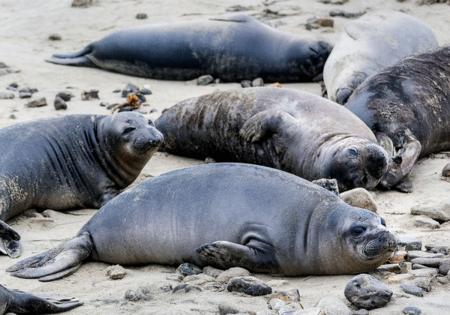Bay Area's elephant seal pups catch the ear of Hollywood sound designers
Published in Entertainment News
SAN JOSE, Calif. — Ferocious human-like monsters that battle hobbits and heroes in the blockbuster film “The Fellowship of the Ring” owe their voices to a serendipitous drive into the fog-swept Marin Headlands and a Bay Area sound designer attuned to unusual sounds.
David Farmer had been hunting vocalizations for the multitudinous “Moria orcs” in the first “Lord of The Rings” movie and “needed something new and cool.” Sightseeing with his wife, Farmer was not officially working, but his ears were, as always, alert. The couple came across The Marine Mammal Center, which rescues injured and sick seals, sea lions and otters. From behind the main building that overlooks the Pacific came an outlandish cacophony.
“I had never heard that sound before,” said Farmer, 59, of Novato. “And as soon as I heard it, I thought, ‘Oh my God, that is it. That is just exactly what I want.’ ”
The noises were “a little freaky,” he said. “It was kind of high pitched. It wasn’t very deep. It was sort of small and thin, which was also what I was looking for. It wasn’t something chesty like a tiger or a lion, which wasn’t something I’d like for that kind of orc.”
When he contacted the center, the world’s largest marine mammal hospital, he discovered that the young northern elephant seals that arrive in large numbers every spring were making the racket from fenced outdoor pens. He visited twice to record the pups.
Director Peter Jackson “loved it,” and the seal pups’ voices are immortalized in the movie, released in 2001. Look for the scenes in which the orcs attack a trio of hobbits and their companions deep in an underground mine.
Orcs are not the only silver-screen critters with vocalizations borrowed from the otherworldly repertoire of elephant seal pups.
For the Jurassic Park series, George Lucas’ Industrial Light & Magic came to the center with recording gear, and the bloodthirsty velociraptors “have a bit of elephant seal in them,” said Adam Ratner, director of conservation engagement at the center.
In How To Train Your Dragon and its sequel, plus the third in the series that’s coming to theaters in June, the dragon Toothless has a voice that mixes the sounds of young elephant seals — recorded at the center — with noises of elephants, tigers, horses and domestic cats, according to the center and the Dreamworks studio.
In the United States, elephant seals give birth from December to February at four primary locations: Año Nuevo, Point Reyes National Seashore, Piedras Blancas north of San Luis Obispo, and the Channel Islands off Santa Barbara.
“How lucky are we to have this nature documentary in our backyard?” said Ratner, who likens the sounds of young elephant seals to “evil chickens.”
Arriving for a recent elephant seal tour at Año Nuevo State Park north of Santa Cruz, Stefanie Arriola, of Los Gatos, pulled up in the parking lot with her 4-year-old son, Ernie, and a sticker of Toothless on her car window.
“Toothless is his favorite,” said Arriola, 41. She was surprised to learn that the sounds she and her son were hearing from the big-eyed young seals helped create the dragon’s vocalizations. “We’re going to have to watch that movie again tonight, bud,” she told Ernie.
Newborn pups are “about the size of a third grader” — 4-feet long and 75 pounds — Ratner said. During the month they spend guzzling their mother’s milk on the beach, they balloon to 300 pounds, “more than most NFL players,” he said.
Immediately after birth, pups use their voices like human infants, said UC Santa Cruz research scientist Caroline Casey. Hungry? Cry for food. Scared of a looming large adult — males can weigh 5,000 pounds — or a big wave that just crashed ashore? Yell for help.
“They will scream louder and for longer, just like a baby, if they are more distressed,” Casey said.
Mother elephant seals are believed able to identify their own pup by the sounds they make within two or three days of giving birth, but newborns are not known to pick their mothers out of the crowd.
“Pups are basically just screaming sacks of fat,” Casey said. “They will try and nurse from, and will produce those calls to, any mom they come in contact with.”
The young seals’ vocalizations are variable, sometimes shorter, other times longer, sometimes a warble, sometimes a wail, other times a squawk or monkey-like screeching.
“All of it,” Casey said, “just means, ‘Mom!'”
After a month, the young are weaned and their mothers swim off to the open ocean. On the tour at Año Nuevo, the calls of recent “weanlings” sounded to retired IT specialist Marna Owen, of Berkeley, like chimpanzees and sometimes resembled war cries.
“They also sound like they’re laughing,” said Owen, 69.
Año Nuevo interpreter Gabby Bates said visitors often mention Star Wars when they hear the pups.
“They remind them of aliens,” said Bates, 24.
The pups, more than 1,200 at Año Nuevo this year, are noisiest while nursing, from birth until early- to mid-February. Young seals typically remain until April, still creating a din, making increasingly daring forays into the ocean.
Perils await. Storms may wash pups away from their mothers. Infections may afflict them. White sharks gather near rookeries for a buffet as weanlings begin heading out to sea. Scientists believe half perish in their first year, while only a quarter make it to age 4.
At The Marine Mammal Center, undernourished, sick or injured elephant seal pups usually start trickling in during February, after beachgoers call the center’s hotline and specialists are dispatched to rescue them. Many more arrive in mid-March through May. Veterinary staff and volunteers typically provide care for two to five months to heal and fatten them for return to the wild.
From observing young elephant seals no longer with their mothers, Ratner believes their calls, the sounds recorded for Hollywood films, seem to mean one of three things: They’re hungry, their space is being invaded, or they’re accosting an interloper.
By mid- to late-April, there usually are 70 to 125 young elephant seals at the center.
“It’s chaos,” Ratner said. “When we have 120 elephant seals here it sounds like we’re being invaded by orcs, or velociraptors.”
_______
How to see young elephant seals in the Bay Area and beyond
Young northern elephant seals can be seen in and around the Bay Area. The animals can be easily observed in their natural environment in three areas, and also at a marine-mammal rehabilitation center near Sausalito, where Hollywood sound specialists have come to record the otherworldly vocalizations of these animals. Costs range from free to inexpensive.
Año Nuevo State Park (21 miles north of Santa Cruz)
When: Females come ashore to give birth from late December to early February. Mothers nurse their pups for only a month before mating and heading out to the open ocean. Pups typically stay through March.
How: Through March 31, elephant seals can be viewed via 2.5-hour docent-led walks, involving a moderate, 3- to 4-mile hike on varied terrain that includes sand dunes. Tours operate rain or shine. The tours start up again Dec. 15, and are available every day, except Christmas Day and Feb. 1-2.
Cost: Tours are $7 per person plus a $3.99 reservation fee. Children age 4 and under are free. Online reservations are highly recommended, especially for weekends and holidays.
Phone: (650) 879-2025
Point Reyes National Seashore (37 miles north of San Francisco)
Elephant seals can be viewed at the Elephant Seal Overlook near Chimney Rock; at the South Beach Overlook just north of the Point Reyes Lighthouse visitors’ parking lot; and on the beach beside the Kenneth C. Patrick Visitor Center.
When: Females typically start giving birth in late December. Pups may stay into April.
How: Roads in the National Seashore provide easy access to areas for viewing. Areas and roads may be closed at times to protect the animals.
Cost: Free
Phone: (415) 464-5100
Piedras Blancas State Marine Reserve (50 miles north of San Luis Obispo)
When: Mothers begin giving birth in mid-December, with pupping continuing into February. The young seals usually depart in March, and some may remain into early April.
How: Parking lots are beside Highway 1 about a mile south of the entrance to the Piedras Blancas Light Station Natural Area. Accessible boardwalks extend from the north and south side of the parking lot, and paths lead to observation platforms.
Cost: Free
Phone: (831) 649-2870
The Marine Mammal Center in the Golden Gate National Recreation Area (at the north end of the Golden Gate Bridge)
When: The center begins to receive sick or injured pups around February, and many more arrive in mid-March through May.
How: Various tour options
Cost: Self-guided tours: free. Tablet tour: $5. Guided tours: $15 adults, $8 students and seniors. Behind-the-scenes tour: $20 adults, $10 students and seniors.
Phone: (415) 653-1870
__________
©2025 MediaNews Group, Inc. Visit at mercurynews.com. Distributed by Tribune Content Agency, LLC.






















Comments